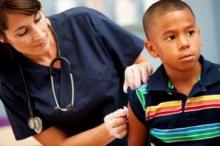As early as fifth grade, black and Latino children show striking disparities across a broad range of health-related behaviors, experiences, and outcomes, compared with non-Latino white children, according to a study published Aug. 22 in the New England Journal of Medicine.
Data have been limited for the pediatric population concerning disparities in such health-related problems as witnessing or perpetrating violence, smoking, not using seat belts, obesity, experiencing discrimination, and drinking alcohol.
Until now researchers have not conclusively shown that these problems, which are thought to be typical of adolescence, may be rooted in earlier childhood, said Dr. Mark A. Schuster of Boston Children’s Hospital and his associates.
"In our study, the prevalence rates of many problems were high, and significant disparities already existed among preadolescents. The overall pattern of disparities in our preadolescent sample closely resembled that for older age groups, with black children having the greatest number of disparities, followed by Latino children," they noted.
Dr. Schuster and his colleagues examined the rates of a broad range of problems known to contribute heavily to morbidity and mortality, using data from a Centers for Disease Control and Prevention (CDC) study of 5,119 fifth-graders and their parents residing in the Birmingham, Ala.; Houston; and Los Angeles areas.
The 16 health-related measures they assessed were witnessing a physical assault, witnessing a threat or injury with a gun, victimization by peers, perpetrating nonphysical aggression, perpetrating physical aggression, cigarette smoking, alcohol use, seat belt use, bike-helmet use, experiencing discrimination, worrying about terrorism, obesity, vigorous exercise, health status, psychological quality of life, and physical quality of life.
Many of these are major contributors to unintentional injuries, which are the leading cause of death among both children and adolescents, and to violence, which is the second largest cause of death in adolescents. Many also cause dysregulation of physiologic stress responses and are associated with substantial mental and physical health problems among youths, the investigators said (N. Engl. J. Med. 2012;367:735-45 [doi: 10.1056/NEJMsa1114353]).
There were significant differences in all 16 health-related measures between black children and white children, and significant differences in 12 of the measures between Latino children and white children.
For example, 20% of black fifth-graders had witnessed a threat or an injury with a gun, compared with 11% of Latino and 5% of white fifth-graders, in unadjusted analyses. And the number of days during the preceding week in which the study subject had engaged in vigorous exercise was markedly lower for black children (3.56 days) and Latino children (3.77 days) than for white children (4.33 days).
Also in unadjusted analyses, compared with white fifth-graders, black fifth-graders were 5% more likely to smoke cigarettes, 15% less likely to use seat belts, 36% less likely to use a bike helmet, and 12% more likely to be obese. Compared with white fifth-graders, Latino fifth-graders were 11% less likely to use seat belts, 32% less likely to use a bike helmet, and 15% more likely to be obese.
However, for almost all of the 16 health measures, adjusting the data to account for variables such as the child’s sex and the parent’s income, education, and marital status eliminated or dramatically reduced most of these disparities.
For example, in adjusted analyses the disparities between black children and white children disappeared for 6 of the 16 health measures, were reduced by half for another 5 measures, and were reduced by approximately a third in the remaining 5 measures. Similarly, in adjusted analyses, 7 of the 12 disparities between Latino children and white children disappeared, 2 were reduced by half, and the remaining 3 were reduced by approximately a third.
The two variables that contributed the most to the disparities among racial/ethnic groups were the child’s school and socioeconomic status.
The study findings demonstrate to physicians that "some consequential health-related behaviors and experiences that are associated with adolescence have already begun in elementary school. Even when they have not, counseling and screening can reasonably begin in anticipation of what may soon emerge," Dr. Schuster and his associates said.
The results also suggest that efforts to change school environments – for example, school-based antibullying programs – may "merit particular consideration." Parent and child health education that subsidizes safety equipment might also reduce some of the disparity for children in lower socioeconomic groups, they added.
Among the study’s limitations, investigators said, is that the data are from just three metropolitan areas. “The results might differ elsewhere, especially where differences in socioeconomic status are smaller,” they wrote. Further, they added, other than body-mass index, all measures in the study were self-reported by the children or their parents.


